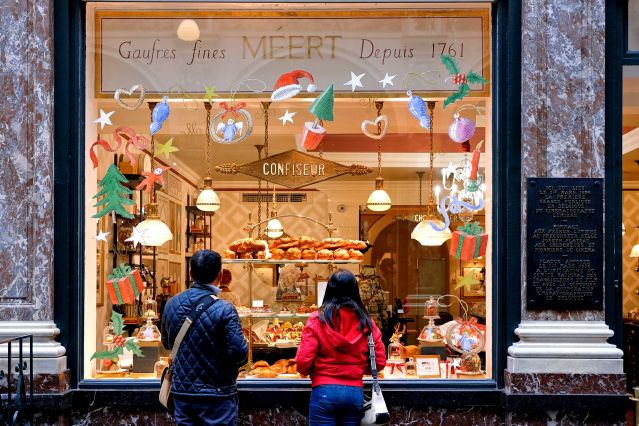Consumer Behavior
What Last Minute Shoppers and Art Enthusiasts Have in Common
The emotional space of aesthetic engagements.
Posted December 22, 2023 Reviewed by Tyler Woods
Key points
- Aesthetic emotions are experienced in a context-dependent way.
- Consumer experiences are goal-directed, but also include an evaluative component just as art viewing does.
- Memorable shopping experiences share features of emotional responses to standout engagements with art.
- Consumer experience is a species of aesthetic engagement.

Guest essay by Eileen Cardillo, D.Phil.
No sooner have we digested the stuffing and apple pie than we are confronted by Black Friday, Small Business Saturday, Cyber Monday, and a frenzied buffet of ads and twinkly window facades encouraging a holiday shopping binge. I teach my young children that Thanksgiving heralds the onset of Giving Season, a festive opportunity to give back to the communities, friends, and family we are so thankful for. I would forgive them should they instead infer that 'tis the season of the Great Festival of the Shopper. As last-minute types scramble to complete their holiday shopping this week, they may find their haste (tick off this to-do list!) at odds with their good intentions (find a meaningful gift). What’s a desperate procrastinator to do? Research from empirical aesthetics suggests a strategy to offset the shopping stress: follow your feelings.
Everyday Aesthetics and Consumer Experience
Engaging with the arts or nature are widely agreed upon prototypical aesthetic experiences. Such activities have been the traditional focus of the philosophy of aesthetics and its empirical study in the past century. However, anything can be an “aesthetic” experience in principle. Recently, scholars have directed their attention to so-called “everyday aesthetics”1 – from how we style our hair, plate our food, decorate our homes, and landscape our yards to the clothes we wear, cars we purchase, and mates we choose. Whether one construes everyday aesthetics narrowly to encompass only the quotidian, commonplace, and ordinary2,3 or more expansively to include common but infrequent experiences like childbirth4, consumer experiences qualify as prototypical exemplars of this domain.
The nascent field of consumer psychology has demonstrated the importance of aesthetic properties like color, packaging, design, and logos for consumer preferences and behaviors like brand loyalty and probability of purchasing5. Citing examples like Legos, AirBnB, and Apple, some contend that the aesthetic value of a product or service is what dictates its long-term success in a crowded market of equally functional competitors6. Moreover, these aesthetic preferences inform how we feel about products and services we consider buying; studies show 85 to 95 percent of buying decisions are driven by emotions, not analytical considerations like functionality6,7.
Measuring Aesthetic Emotions
In a recently published paper8, we asked: Are the emotions elicited by prototypical aesthetic experiences like engaging with the arts the same as those engaged by everyday activities with aesthetic evaluations, like buying a new phone? Nearly 800 participants were randomly assigned to recall in detail one of three types of memory: an engagement with art (listening to music, watching a film, seeing a ballet, looking at a painting, reading a book, etc.), an engaging non-aesthetic activity (such as listening to a lecture, watching a debate, looking at a map, or reading the news), or an engaging experience buying something in a store (like buying a phone, car, computer, clothes, housewares, etc.). The consumer condition plumbs a domain intermediate between aesthetic and non-aesthetic contexts in that it has an evaluative component like arts activities but is goal-directed in its aims (i.e., to buy something), unlike arts activities.
After reporting their memory in detail, participants rated the experience for 75 proposed aesthetic emotions9. Applying semantic network analyses to these responses, we were able to visually map the relationships between these emotions and to quantitatively compare the emotional space of each context. Consistent with our expectations, the class of aesthetic emotions were more relevant to arts engagements than other memorable activities, and were uniquely organized in this context. The emotional space of the aesthetic network clustered into five communities of closely related emotions:
- Prototypical: touched, moved, meaningful
- Energizing: enthusiastic, invigorated, energized
- Pleasing: perfection, delight, harmony
- Captivation: interest, engaged, fascinated
- Negative: dislike, distaste, uncomfortable
Memorable Consumer Engagements
Despite differences in overall structure, which include the observation that emotions are felt more intensely in aesthetic than in consumer contexts, at finer-grain levels, we observed similarities between emotional profiles of engaging with art and of making a purchase.
Memories of consumer experiences were organized into three loose communities. As in the arts context, one consisted of negative emotions. Another included most of the prototypical aesthetic emotions. The third consisted of many of the pleasing emotions.
The emotions of the energizing and captivating clusters were more broadly distributed. These communities suggest three routes to purchasing decisions. When prototypical aesthetic emotions are encountered in a consumer context, this may translate to appraising a potential purchase as personally meaningful – which motivates buying. The cohort of pleasing states in the second community suggests buying is motivated because a product makes the consumer feel good. Most likely, experiencing negative emotions makes a shopper unlikely to buy something.
We also compared the emotions that were most central to each context’s network, again observing overlap in the emotional terrain of arts and consumer experiences. The three gold standards of aesthetic evaluation—beauty, liking, and interest—were of central relevance to both. This “core” analysis also confirmed the relevance of prototypically aesthetic states (moved, touched, wonder) in consumer experiences, further aligning these encounters with traditional aesthetic engagements like viewing art. Other core emotions in this context suggested the importance of feeling pleasure (cheerful, happy, delight, pleasant), motivation (energized, motivated, impressed, inspired), and novelty (surprised, shocked, stimulated, curious) in memorable consumer experiences.
Eleventh-Hour Aesthetic Decisions
Aesthetic emotions are not a unique class of emotions only evoked by the arts; they are a suite of emotions that are weighted differently depending on context. Patterns of overlap between arts engagements and shopping experiences support conceptions of consumer behavior as a species of aesthetic experience5,6. Holiday shoppers racing to this year’s finish line can log another set of rushed, forgettable purchases in the books. Or, they can make a lasting, fond memory by going for the purchases that move or delight them. With any luck, they’ll be as memorable for their recipients, too.
References
Leddy, T. (2012). The extraordinary in the ordinary: The aesthetics of everyday life. Broadview Press.
Melchionne, K. (2013). The definition of everyday aesthetics. Contemporary Aesthetics (Journal Archive), 11(1), 26.
Naukkarinen, O. (2013). What is 'everyday' in everyday aesthetics?. Contemporary Aesthetics (Journal Archive), 11(1), 14.
Leddy, T. (2015). Experience of awe: An Expansive approach to everyday aesthetics. Contemporary Aesthetics (Journal Archive), 13(1), 8.
Patrick, V. M. (2016). Everyday consumer aesthetics. Current Opinion in Psychology, 10, 60-64.
Brown, P. (2019). Aesthetic intelligence: How to boost it and use it in business and beyond. Harper Collins.
Magids, S., Zorfas, A., & Leemon, D. (2015). The new science of customer emotions. Harvard Business Review, 76(11), 66-74.
Kenett, Y. N., Cardillo, E. R., Christensen, A. P., & Chatterjee, A. (2023). Aesthetic emotions are affected by context: a psychometric network analysis. Scientific Reports, 13(1), 20985. https://doi.org/10.1038/s41598-023-48219-w
Schindler, I., Hosoya, G., Menninghaus, W., Beermann, U., Wagner, V., Eid, M., & Scherer, K. R. (2017). Measuring aesthetic emotions: A review of the literature and a new assessment tool. PloS one, 12(6), e0178899


